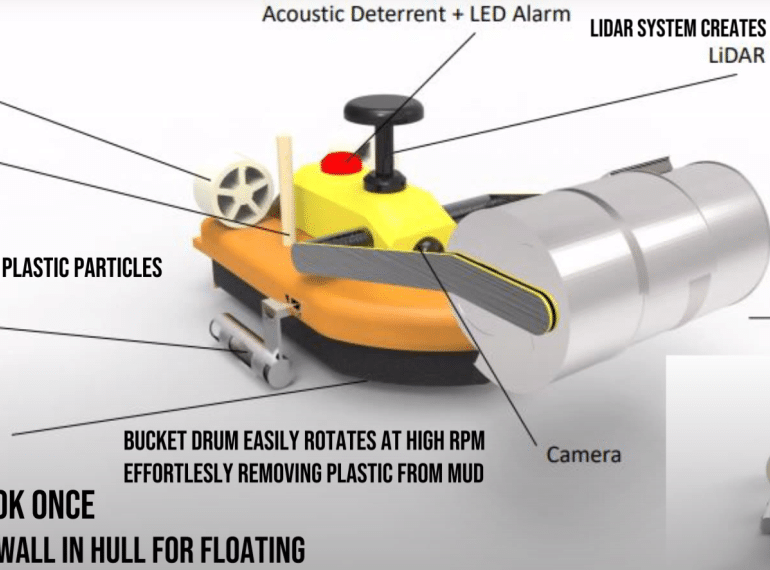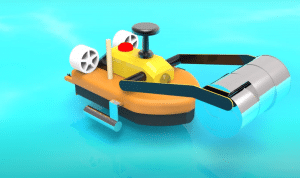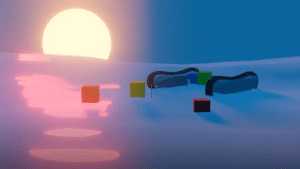Multi-disciplinary magic helps QE to a top place in international competition

A Year 10 team’s hi-tech lockdown project was placed third in an international competition aimed at stemming the global tide of plastic pollution.
 The Prata Neptunia team combined their skills in Technology, Mathematics and Chemistry and also produced a slick video presentation to promote their design for an autonomous hovercraft robot.
The Prata Neptunia team combined their skills in Technology, Mathematics and Chemistry and also produced a slick video presentation to promote their design for an autonomous hovercraft robot.
Competing against teams from more than 40 countries, Ashwin Sridhar, Anish Rana and Merwan Singh impressed judges from the British International Education Association with their use of artificial intelligence to tackle plastic waste in rivers and canals, reducing its harmful effects on flora and fauna.
A second QE Year 10 team, called Ocean, won the Best Effort prize in their category in the competition, which was launched in January.
Head of Technology Michael Noonan said: “My heartfelt congratulations go to the boys, who began their projects when we were deep in lockdown and thus had to overcome some significant obstacles in putting their entry together. Although narrowly missing out on the grand prize, the team are proud to have had their project acknowledged on an international scale and to have learned countless new skills along the way.”
The BIEA International STEM Innovation Challenge invited young people from the age of nine to 21 to research, write a report and design a solution to Save our shores from plastic waste through STEM (Science, Technology, Engineering, Mathematics). In its brief, the BIEA pointed out that one lorryload of plastic is dumped every minute worldwide – the annual equivalent in weight of 40,000 blue whales or 1.6 million elephants. The competition drew entries from schools in countries including China, the United States, Argentina, Norway and Indonesia.
Ashwin took on the role of Project Manager and Lead Scientist for Prata Neptunia, while Merwan was Lead Researcher and Anish the Lead Robotics Designer.
By using hovercraft technology informed by artificial intelligence, the trio were able to devise a design that could travel across multiple terrains, both land and water, and target different types of plastic. These notably included microplastics, which have become a huge problem worldwide because of their devastating effects on marine life.
 The team learned project-management skills in order to optimise their time effectively, from the use of Gantt charts to task delegation. They designed prototypes at home, building and testing parts, and investigating processes to remove microplastics in order to determine the feasibility of their design.
The team learned project-management skills in order to optimise their time effectively, from the use of Gantt charts to task delegation. They designed prototypes at home, building and testing parts, and investigating processes to remove microplastics in order to determine the feasibility of their design.
As part of the overall design process, they applied skills acquired in Technology lessons before finally designing their solution on CAD software.
Their work led to an invitation from BIEA to participate in the virtual international finals, where they were awarded their third place in the 15-17 category.
Anish said: “We started our journey back in March and were quite behind, compared to other teams, which started earlier. However, through thoughtful planning and hard work, we were able to pull together to create a product we were proud of in time for the due date.”
Unable to meet up freely or access all the resources of The Queen’s Library, the boys worked from home and used technology including Zoom calls to co-ordinate their work.
“We all saw plastic pollution as a big problem all over the world: the BIEA competition has targeted a global crisis that needs fixing.”
The competition gave him and his teammates the opportunity to deploy their skills and knowledge to tackle this crisis, which, he said, has shown him “how we can all work together to solve it”.
Anish added: “Of course, we had our ups and downs, but overall the competition was a great experience with a satisfying conclusion.”
The trio’s project required some fairly advanced Science, as they investigated methods of removing plastics, which led to their inclusion of PETase, an enzyme which catalyses the hydrolysis of Polyethylene terephthalate (PET) to monomeric mono-2-hydroxyethyl terephthalate (MHET). MHET is then broken down into Ethylene glycol and Terephthalic acid (Benzene-1,4-dicarboxylic acid) using the enzyme MHETase. The team also delved into fluid dynamics – encompassing Mathematics and Physics – to optimise their design’s motion and efficiency.
 The Ocean team, Jashwanth Parimi, Utkarsh Bhamidimarri and Siddarth Jana, also started their project relatively late and had only about a month to complete it.
The Ocean team, Jashwanth Parimi, Utkarsh Bhamidimarri and Siddarth Jana, also started their project relatively late and had only about a month to complete it.
Jashwanth said: “During multiple Zoom calls, we learned much more about plastic pollution and, eventually, we designed an idea that we thought was suitable for solving the problem. Then we each split into our specialised areas to fulfill the requirements of the project, but we still all helped each other in each of our project areas until we finally finished.”
The team designed a multi-terrain vehicle that used a net in order to collect macro-plastics on both the ocean and the mudflats. “Our project was innovative since we tried to consider all the wildlife on all the terrains, such as fish and snails, and so on.”
